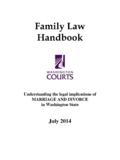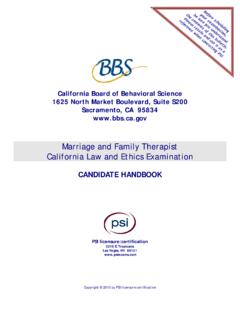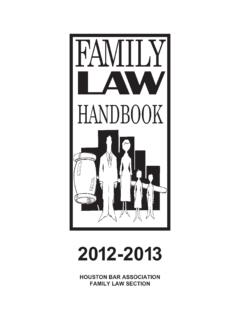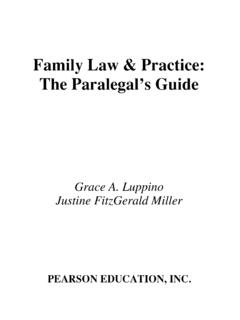Transcription of Research Handbook on the Economics of Family Law
1 Research Handbook on the Economics of Family LawEdited byLloyd R. Cohen and Joshua D. WrightGeorge Mason University, USARESEARCH HANDBOOKS IN LAW AND ECONOMICSE dward ElgarCheltenham, UK Northampton, MA, USAM2634 - COHEN iiiM2634 - COHEN iii27/06/2011 16:4027/06/2011 16:40 The Editors and Contributors Severally 2011 All rights reserved. No part of this publication may be reproduced, stored in a retrieval system or transmitted in any form or by any means, electronic, mechanical or photocopying, recording, or otherwise without the prior permission of the byEdward Elgar Publishing LimitedThe Lypiatts15 Lansdown RoadCheltenhamGlos GL50 2 JAUKE dward Elgar Publishing, Pratt House9 Dewey CourtNorthamptonMassachusetts 01060 USAA catalogue record for this bookis available from the British LibraryLibrary of Congress Control Number: 2010939252 ISBN 978 1 84844 437 9 (cased)Typeset by Servis Filmsetting Ltd, Stockport, CheshirePrinted and bound by MPG Books Group, UKM2634 - COHEN ivM2634 - COHEN iv27/06/2011 16:4027/06/2011 16:40964 Trends in marital stability*Betsey Stevenson and Justin Wolfers1.
2 INTRODUCTIONThis chapter documents trends in marital stability over recent decades. Our assessment is motivated by a desire to update earlier analyses with the latest data, as well as an attempt to reconcile apparently confl icting results. The reconciliation points to an unequivocal increase in marital stability since the and Wolfers (2007) analyzed retrospective marital histories from the 2001 Survey of Income and Program Participation (SIPP), fi nding that fi rst marriages occur-ring in each decade since the 1970s have been less likely to end in divorce than marriages begun in the preceding decade. This analysis (as originally published) is presented in Figure The fi nding of a lower likelihood of divorce among those who married in recent decades appears to hold irrespective of how many years into these marriages one assesses the cumulative divorce rate.
3 The Census Bureau (2005) also analyzed these data and their analysis of the survival of fi rst marriages at each anniversary (a function of both divorce and death), reproduced as Table , points to a similar trend of more stable marriages among those who wed in recent recently released marital history data from the 2004 SIPP has been analyzed by the Census Bureau (2007a). In contrast to what was previously found, their tables suggest that there has been a recent rise in marital instability for marriages of all durations and that both fi rst and second marriages since the mid- 1970s were less likely to survive to celebrate 10th, 15th, 20th, or higher anniversaries than previous marriage cohorts. These data are presented, as published, in Table Coverage of this data release in the popular press emphasized that a minority of marriages were likely to reach their silver (25th) anniversary, and reported that marital dissolution has risen in the United States over recent Given the importance of accurate measurement of Family change for * We would like to thank Claudia Goldin for pointing us to the anomalous fi ndings reported in this chapter and Nico Lacetera, Stephanie Coontz and again, Claudia Goldin for encouraging us to write up these fi ndings.
4 Erik Knodder and Hao Wang provided helpful comments. We are grateful to Martin O Connell and Census Bureau staff for help in understanding the survey design and procedures underlying the SIPP. We thank the Zell/Lurie Real Estate Center for gener-ous Research For instance, the New York Times reported that For the fi rst time at least since World War II, women and men who married in the late 1970s had a less than even chance of still being married 25 years later. The same article continued, arguing that the latest numbers suggest an uptick in the divorce rate among people married in the most recent 20 years covered in the report, 1975 1994. ( 25th Anniversary Mark Elusive for Many Couples , by Sam Roberts, New York Times, September 20, 2007). Similarly, the Washington Post reported that For the fi rst time since World War II, America s married couples are more likely to have split by the 25- year mark than to have stayed together.
5 ( Most Marriages Don t Last 25 Years , Washington Post, September M2634 - COHEN 96M2634 - COHEN 9627/06/2011 16:4027/06/2011 16:40 Trends in marital stability 97policymakers, it is imperative to both reconcile these competing claims and to present a clearer picture of the underlying begin by emphasizing the similarities in the analytic approaches taken. In each case, the analyses are based on conceptually similar data self- reported marital histo-ries drawn from representative cross- sections surveyed as part of the Survey of Income and Program Participation in 2001 and 2004, respectively. In particular, these data are representative of those spouses who survived until the survey The approaches are 19, 2007). A front page story in the Philadelphia Inquirer asked rhetorically Looking forward to your 25th anniversary? responding that if so, you should Count yourself among a shrinking minority, continuing to note that the Census report reinforces studies that have reported that American marriages are not as durable as they once were.
6 ( Silver Becomes Rarer Milestone , by Andrew Maykuth, Philadelphia Inquirer).2 The weaknesses of self- reported data are common to each of these studies. Unfortunately, administrative panel data on marital status are not available for the United States and systematic counting of divorce certifi cates by year of marriage ceased in 1995. As such, these marital history data are particularly policy 591960 691970 791980 891990 of marriages ending in divorceconditional on being married but not widowed0510152025 Years since weddingFirst marriages ending in divorce, by year of marriageNotes: Figure drawn from Stevenson and Wolfers (2007). We show the relevant data where we can calculate cumulative divorce probabilities for at least three of the ten annual marriage cohorts represented by each line. We exclude data on marital status in 2001, because the survey did not account for all divorces in that : Authors calculations based on Survey of Income and Program Participation (SIPP), 2001 Panel, Wave 2 Topical Cumulative divorce probabilities, 2001 SIPPM2634 - COHEN 97M2634 - COHEN 9727/06/2011 16:4027/06/2011 16:4098 Research Handbook on the Economics of Family lawsimilar in that each of these studies focus on marriage cohorts groups who had a fi rst (or second) wedding in a particular period, reporting the share of each group to have achieved particular milestones (divorce, or a wedding anniversary) by the survey date.
7 Thus, similarities in the results across each study would not be surprising. And indeed, if Table Census Bureau analysis of 2001 SIPP marital historiesSex and year of marriage Number of marriages (in thousands)Anniversary15th 10th15th 20th25th30th35th40thFIRST MARRIAGESMen1955 to 19594, to 19645, (X)1965 to 19696, (X)(X)1970 to 19747, (X)(X)(X)1975 to 19797, (X)(X)(X)(X)1980 to 19847, (X)(X)(X)(X)(X)1985 to 19898, (X)(X)(X)(X)(X)(X)1990 to 19947, (X)(X)(X)(X)(X)(X)(X)Women1955 to 19595, to 19645, (X)1965 to 19697, (X)(X)1970 to 19748, (X)(X)(X)1975 to 19797, (X)(X)(X)(X)1980 to 19848, (X)(X)(X)(X)(X)1985 to 19898, (X)(X)(X)(X)(X)(X)1990 to 19947, (X)(X)(X)(X)(X)(X)(X)SECOND MARRIAGESMen1975 to 19791, (X)(X)(X)(X)1980 to 19842, (X)(X)(X)(X)(X)1985 to 19892, (X)(X)(X)(X)(X)(X)1990 to 19942, (X)(X)(X)(X)(X)(X)(X)Women1975 to 19792, (X)(X)(X)(X)1980 to 19842, (X)(X)(X)(X)(X)1985 to 19893, (X)(X)(X)(X)(X)(X)1990 to 19943, (X)(X)(X)(X)
8 (X)(X)(X)Notes:X Not Percentage of people reaching stated anniversary for specifi ed marital : Census Bureau, Survey of Income and Program Participation (SIPP), 2001 Panel, Wave 2 Topical Module. Reproduction of Table 2 from Census Bureau (2005).M2634 - COHEN 98M2634 - COHEN 9827/06/2011 16:4027/06/2011 16:40 Trends in marital stability 99one focuses on the fi ve- year anniversary, Table , Table , and Figure all suggest that marital stability has been fl at or slightly rising subsequent to the data on survival to 10th, 15th, 20th or 25th anniversaries drawn from Table appear to suggest a continuation of this trend, while the data from Table suggest a Tab le Census Bureau analysis of 2004 SIPP marital historiesSex and year of marriage Number of marriages (in thousands)Anniversary15th 10th15th 20th25th30th35th40thFIRST MARRIAGESMen1955 to 19593,884 to 196424,602 to 196926,161 (X)1970 to 197427,075 (X)(X)1975 to 197927,001 (X)(X)(X)1980 to 198427,625 (X)(X)(X)(X)1985 to 198927,838 (X)(X)(X)(X)(X)1990 to 199428,070 (X)(X)(X)(X)(X)(X)
9 Women1955 to 19594,890 to 196425,548 to 196927,023 (X)1970 to 197428,139 (X)(X)1975 to 197927,714 (X)(X)(X)1980 to 198428,058 (X)(X)(X)(X)1985 to 198928,064 (X)(X)(X)(X)(X)1990 to 199428,546 (X)(X)(X)(X)(X)(X)SECOND MARRIAGESMen1975 to 197921,747 (X)(X)(X)1980 to 198422,306 (X)(X)(X)(X)1985 to 198922,415 (X)(X)(X)(X)(X)1990 to 199422,590 (X)(X)(X)(X)(X)(X)Women1975 to 197921,956 (X)(X)(X)1980 to 198422,568 (X)(X)(X)(X)1985 to 198922,790 (X)(X)(X)(X)(X)1990 to 199422,825 (X)(X)(X)(X)(X)(X)Notes:X Not Percentage of people reaching stated anniversary for specifi ed marital Approximately 10% of the cohort has not reached the stated age by the end of the latest specifi ed time period. Because of this, estimates for this group for the highest anniversary are : Census Bureau, Survey of Income and Program Participation (SIPP), 2004 Panel, Wave 2 Topical Module.
10 Table reproduces Table 2 from Census Bureau (2007a).M2634 - COHEN 99M2634 - COHEN 9927/06/2011 16:4027/06/2011 16:40100 Research Handbook on the Economics of Family lawrecent sharp reversal. For instance, the proportion of the 1990 94 fi rst marriage cohort to celebrate their 10th wedding anniversary appears much lower than the proportion of those wed from 1985 89 ( v. for men; v. for women), suggesting a sharp rise in marital disruption. However, this seems diffi cult to square with predictions one might have made based on the proportions of these cohorts who reached their fi fth wedding anniversary ( v. for men; v. for women).3 Recall, too, that Stevenson and Wolfers (2007) found their results were unaf-fected by the duration at which one assesses the stability of each marital cohort. Similar discrepancies are seen at each subsequent anniversary when comparing the most recent data with the survival of marriages from the preceding fi ve- year marriage cohort.










